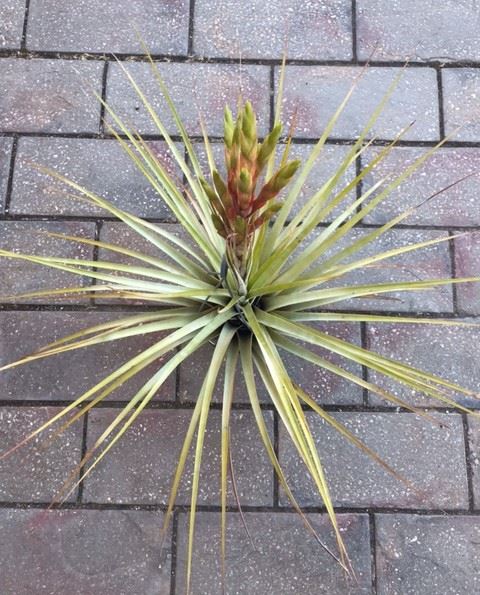
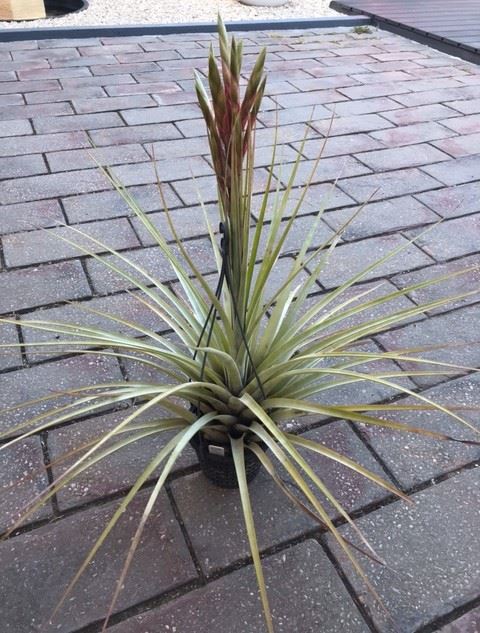

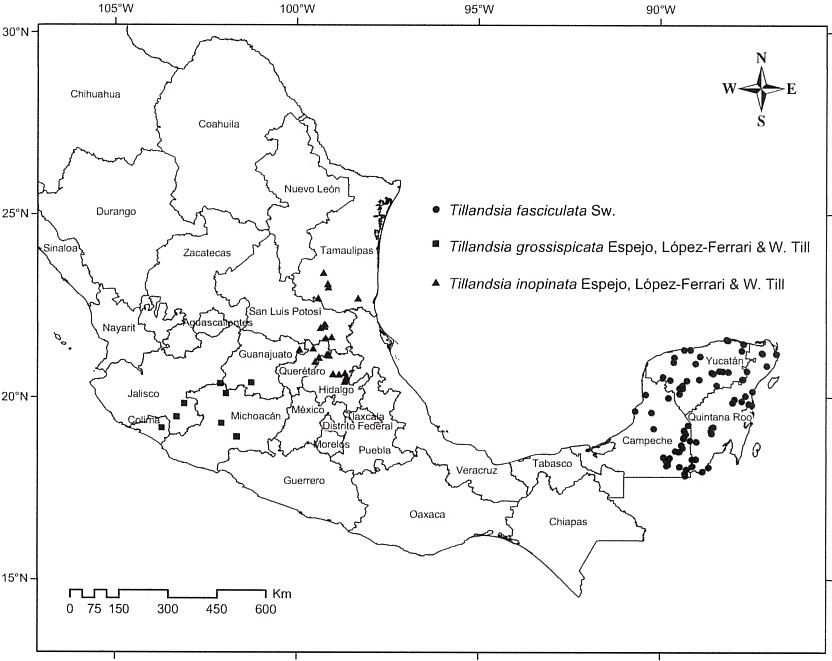
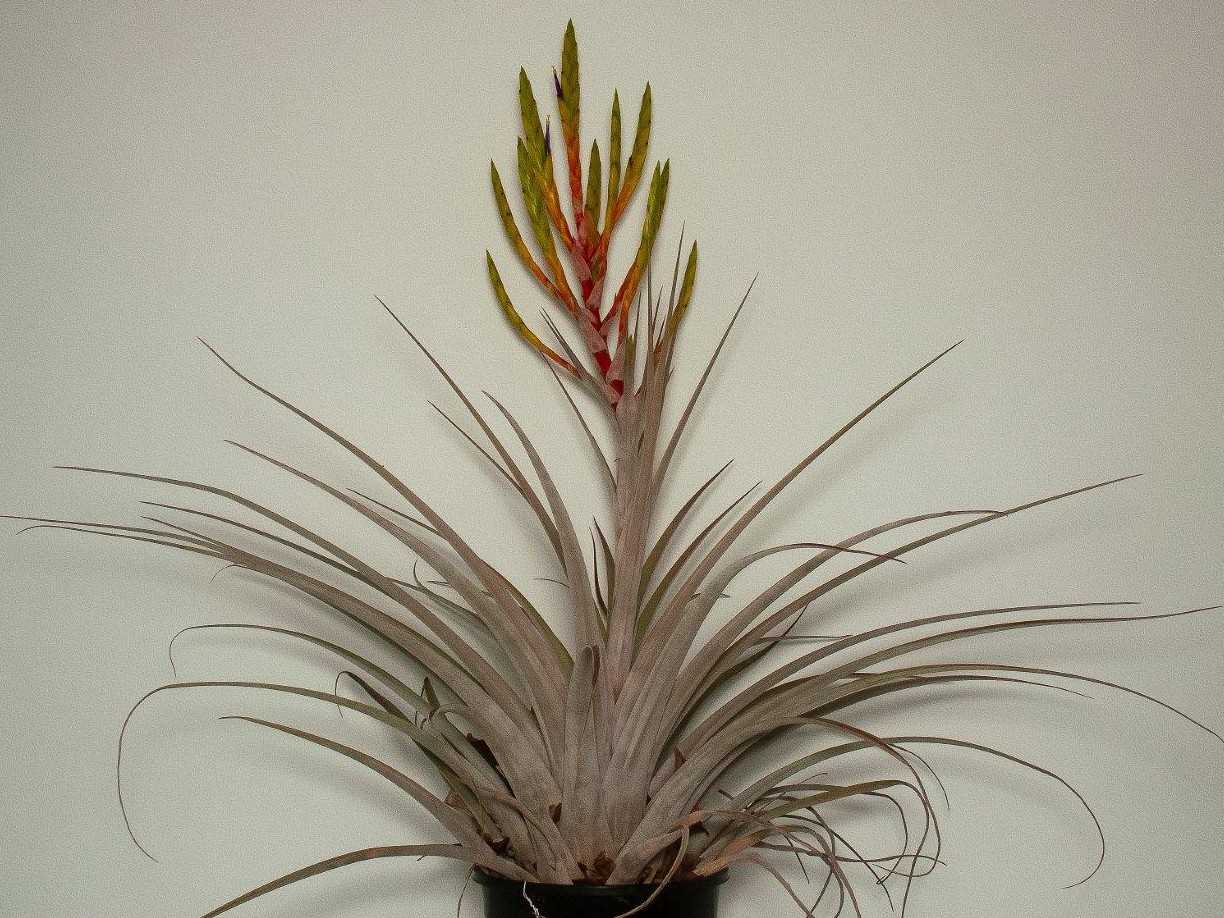

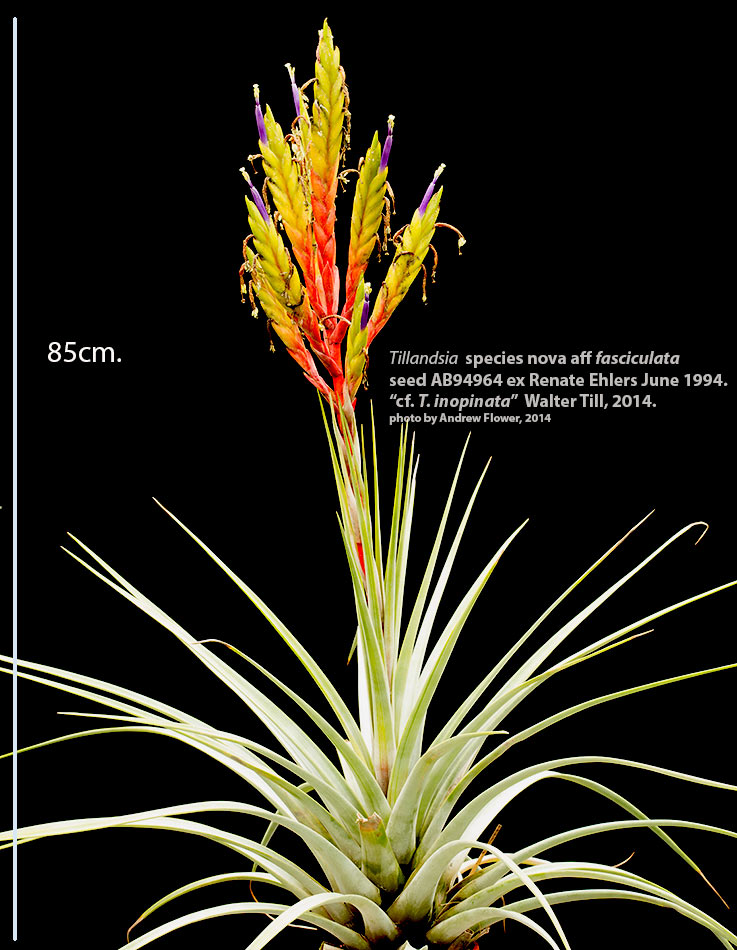

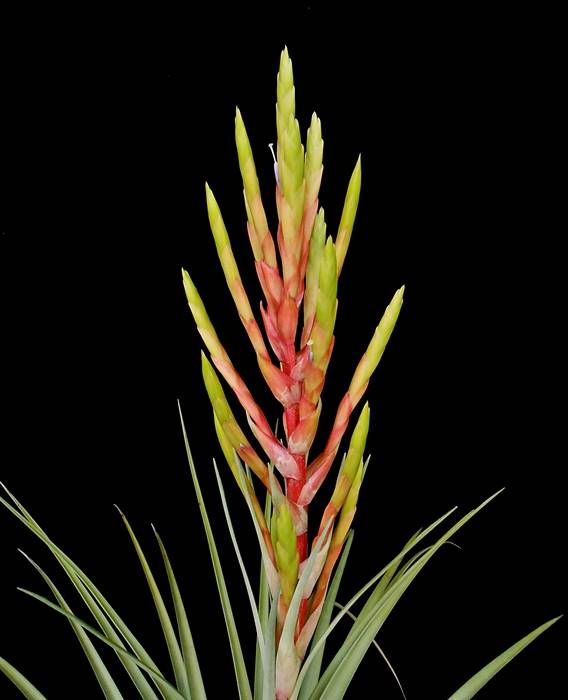
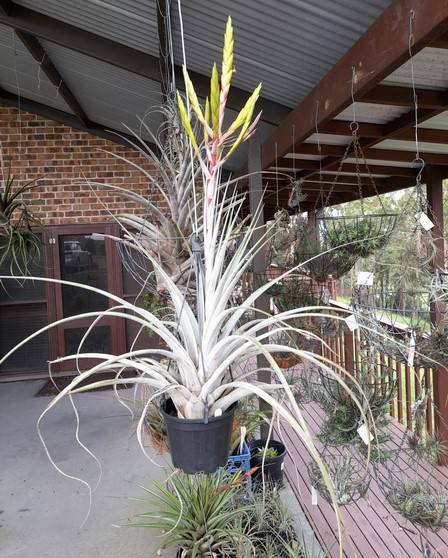

Hierbas arrosetadas, epifitas o litofitas, en flor de hasta 1.5 m de alto, las rose¬tas de hasta 70cm de diametro en su parte mas ancha, solitarias o en grupos de dos o tres, acaules; hojas numerosas, las vainas pardas oscuras en ambas superficies, con una banda transversal parda oscura en la base, ovado elipticas a oblongo elipticas, de 7.5 a 11.5cm de largo, de 4.5 a 6cm de ancho, densa pero inconspicuamente le¬pidotas en ambas superficies, las laminas verdes grisaceas, largamente triangulares, involutas, de 30 a 50cm de largo, de 2.3 a 2.7cm de ancho en la base, densamente blanco lepidotas en ambas superficies, muy largamente atenuadas y algo pungentes en el apice; inflorescencias terminales, erectas, digitado fasciculadas, mas largas que las hojas, con (4)6 a 12 espigas, estas erectas a ascendentes, el pedunculo cilin¬drico, de 25 a 46cm de largo, de 7 a 12mm de diametro, cubierto completamente por las bracteas; bracteas del pedunculo inferiores verdes grisaceas y foliaceas, las superiores verdoso rosadas a rosadas, densamente blanco lepidotas, de 6 a 35cm de largo, de 1 a 1.5cm de ancho; bracteas primarias rosadas a rojas, cortamente foliaceas a vaginiformes, largamente acuminadas, densamente blanco lepidotas, de 3.3 a 6.2cm de largo, de 1.2 a 2cm de ancho, mucho mds cortas que las espigas; las espigas oblanceoladas a largamente oblanceoladas, de 11 a 26.5cm de largo, de 1.2 a 2cm de ancho cuando tienen flores, de hasta 3cm de ancho cuando tienen frutos, fuertemente aplanadas, de 3 a 4mm de grueso, estipitadas, los estipites de 3 a 8cm de largo y totalmente cubiertos por bracteas; bracteas del estipite ovado elipticas, de 2 a 4cm de largo, bracteas florales inferiores rojas o anaranjadas, las superiores verdes a verdes amarillentas, ovado elipticas, de 3.2 a 4.5cm de largo, de 1.6 a 2.2cm de ancho cuando aplanadas, mas largas que los entrenudos, imbricadas, lisas, ex¬cepto hacia el apice que es ligeramente nervado, conspicuamente carinadas, glabras, acuminadas; flores 6 a 18 por espiga, disticas, ascendentes, actinomorfas, tubiformes, sesiles; sepalos verdes, largamente elipticos, de 2.8 a 3.2cm de largo, de 6 a 7mm de ancho, glabros, ligeramente nervados, agudos, los dos adaxiales fusionados en la mitad de su longitud y marcadamente carinados; petalos de color violeta en su mitad apical, blancos en su mitad basal, cintiformes a oblongo espatulados, de 5.7 a 6.1cm de largo por 8 a 8.5mm de ancho, redondeados en el apice, libres; estambres desiguales, exsertos, los filamentos filiformes y blancos en su porcion basal, de color violeta y aplanados en su porcion apical, de 6.3 a 7.2cm de largo; anteras subbasifi¬jas y versatiles, negras, oblongas, de 3.2 a 3.9mm de largo; ovario ovoide, de 9 a 10mm de largo, de ca. 3.2 a 4mm de diametro, verde; estilo linear, de 6.2 a 7.3cm de largo, blanco; estigma conduplicado en espiral (tipo II sensu Brown & Gilmartin, 1984), verde. Capsula fusiforme, verde, de ca. 3cm de largo, de ca. 5mm de diametro, cortamente rostrada; semillas fusiformes, pardas, de 4 a 5mm de largo, con un apendice plumoso blanco, de ca. 2cm de largo.
Tipo: Hidalgo, ATOTONILCO EL GRANDE, Paso del Leon, en la barranca de Metztitlan, 20°40'18" N, 98°40'15" W, 1815 m, 19.IV.2007, A. R. Lopez-Ferrari, A. Espejo, J. Ceja y A. Mendoza R. 3275 (Holotipo: UAMIZ; Isotipos: IEB, MEXU).
Paratipos: Hidalgo, ATOTONILCO EL GRANDE, barranca de Venados, al principio, a 1 km de Paso de Leon, 1800 m, 3 VI 1976, A. Delgado y R. Hernandez 236 (MEXU), Paso del Leon, en la barranca de Metztitlan, 20°40'18" N, 98°40'15" W, 1815 m, cultivado 6 V 2003, A. Mendoza R. 665 (UAMIZ, ejemplar ilustrado); METZTITLAN, barranca de Venados, 8 VIII 1964, L. Gonzalez Q.1202 (ENCB), barranca de Tolantongo, 10 km al W de Cardonal, 1500 m, L. Gonzalez Q. 2567 (MEXU), 3.7 km sobre la desviacion a Agua Bendita, a partir del camino Venados - Meztitlan, 1400 m, 3 V 1986, A. Lopez B., C. Sanchez M. y A. Espejo 37 (IEB, UAMIZ(x2)), canada de Meztitlan, 1300 - 1900 m, 17.IV1891, P. Maury 5765 (GH(x2)), Venadostal, S. Schatzl 76/30 (WU), Venadostal, S. Schatzl 77/7 (WU(x3); SAN AGUSTIN MEZQUITITLAN, dry lime cliffs near top of barranca d e Metztitlan on road from Metzquitlan to Zacualtipan, 24.III.1947, H. E. Moore, jr. 2471(GH, US), 5 km al E de Metzquititlan, 1650 m, 4.IV.1965, J. Rzedowski 19505 (MEXU).
Guanajuato, XICHU, aproximadamente 6.5 km al SE de El Guamuchil, por la brecha a Atarjea, 13 VII 1998, S. Zamudio, E. Perez y L. Hernandez 10788 (IEB, UAMIZ).
Queretaro, ARROYO SECO, 5.8 km despues de Puerto Ayutla, rumbo a Jal¬pan, 21°20'47" N, 99°32'58" W, 8.IX.2006, J. Ceja, A. Espejo, A. R. Lopez-Ferrari y J. Garcia Cruz 1785 (UAMIZ); JALPAN, canon del rio Estorax, ca. de las adjuntas con el rio Moctezuma, 18.XI 2000, E. Perez C. et al. 4089 (IEB(X2)), al sur de Tanquizul, 28.V.1992, L. Lopez Ch. 317 (IEB(x2)), Las Adjuntas, confluencia en¬tre los rios Moctezuma y Estorax, 14-15 V 1993, S. Zamudio R. et al. 9084 (IEB); LANDA DE MATAMOROS, 3 km despues de Tilaco, rumbo a Santa Ines, 21°10'32" N, 99°10'17" W, 1350 m, 15.IV.2000, J. Ceja, A. Espejo, A. R. Lopez-Ferrari y A. Mendoza R. 1068 (UAMIZ), ca. 2 km despues de Santa Ines, rumbo a Agua Zarca, 21°10'53" N, 99°07'28" W, 1150 m, 15.IV 2000, J. Ceja, A. Espejo, A. R. Lopez-Ferrari y A. Mendoza R. 1081 (UAMIZ), Tangojo, orilla del rio Moctezu¬ma, 4.III.1988, H. Diaz Barriga y S. Zamudio R. 4620 (IEB(x2)), 2 km al S de El Rincon, cerca de Tilaco, 2.IV1987, J. Rzedowski 42965 (IEB(x2)), cerca de Santa Ines, proxima a Tilaco, 2.IV1987, J. Rzedowski 42994 (IEB); SAN JOAQUIN, ca. 8 km despues del Apartadero, rumbo a El Platano, 20°59'15" N, 99°29'48" W, 1150 m, 10.IV 2007, J. Ceja, A. Espejo, A. R. Lopez-Ferrari, A. Mendoza R. y S. Zamu¬dio R. 1822 (UAMIZ(x3)).
San Luis Potosi, AQUISMON, ca. 1 km al N de Tanute, 21°39'28" N, 99°02'23" W, 84 m, 8.IX.2003, A. R. Lopez-Ferrari, A. Espejo y J. Ceja 3068 (UAMIZ(x3)); CIUDAD VALLES, vicinity of San Dieguito, 7-10.VI.1905, E. Palmer 646 (GH, MO, US(x2)); TAMASOPO, ca. 60 km despues de Cardenas, rumbo a Ciudad Valles, 5 km despues de la desviacion a Tamasopo, 21°54'22" N, 99°21'05" W, 640 m, 5.IX.2003, A. Espejo, A. R. Lopez-Ferrari y J. Ceja 6639 (UAMIZ(x4)), 800 m antes de llegar a Rascon, partiendo de la carretera Rio Verde - Ciudad Valles, 21°56'27" N, 99°14'13" W, 295 m, 5.IX.2003, A. Espejo, A. R. Lopez-Ferrari y J. Ceja 6647 (UAMIZ(x3)), at Rascon, 21 VI 1892, C. G. Pringle 4172 (sintipo de T. fasciculata Sw. var. latispica Mez: GH, MEXU, P(x2), US(X2), WU).
Tamaulipas, ALDAMA, cerca de Manuel, 22°43'20" N, 98°18'50" W, 800 m, 14 V 1982, F. Gonzalez Medrano y P. Hiriart V. 12536 (MEXU); GOMEZ FARIAS, 2 km al W de Gomez Farias, postrimerias de la Sierra Madre Oriental, 23°1'35" N, 99°7'56" W, 450 m, 4.IX.1982, A. Paliente B., P. Diaz M. y J. I. Solis A. 299 (MEXU); JauMavE, reserva de la biosfera El Cielo, canon 1 km al SE de Los Nogales, 23°25'10" N, 99°16' W, 700 m, 23.XI 1993, L. Hernandez S. 2821 (MEXU); LLERA, valle del rio Sabinas, rancho El Cielito, 4 km S de La Libertad, 23°6'50" N, 99°8'50" W, 8.IX.1984, McDonald 781 (MEXU); OCAMPO, 1 km al N de R. Flores Magon, 22°43'25" N, 99°24'45" W, 330 m, 20.II.1982, F. Gonzalez Medrano y A. Valiente B. 12140 (MEXU).
Tillandsia inopinata, endemica de Mexico y conocida de los estados de Gua¬najuato, Hidalgo, Queretaro, San Luis Potosi y Tamaulipas, crece en diversos tipos de matorrales, asi como en bosques tropicales caducifolios y subcaducifolios y en encinares, entre los 80 y los 1800 m de altura. Florece de abril a agosto.
Los ejemplares de los dos nuevos taxa aqui propuestos habian sido previamente identificados como Tillandsia fasciculata Sw., debido seguramente a la inflorescencia digitado-fasciculada que todas presentan, sin embargo existen evidentes diferencias entre ellas como puede apreciarse en el Cuadro 1 y en las figuras 1 a 5.
Translated by Derek Butcher
Herb rosette, epiphytic or lithophytic, flowering up to 1.5m high, the rosette up to 70cm diameter in its widest part, solitary or in groups of two or three, acaulis;
Leaves numerous,
Sheaths dark brown on both surfaces, with a dark brown traverse band at the base, elliptic ovate to oblong elliptic, 7.5 to 11.5cm long, 4.5 to 6cm wide, dense but inconspicuously lepidote on both surfaces,
Blades grey green, long triangular, involute, 30 to 50cm long, 2.3 to 2.7cm wide at the base, densely white lepidote on both surfaces, very long attenuate and somewhat pungent at the apex;
Inflorescence terminal, erect, digitate-fasciculate, longer than the leaves, with (4) 6 to 12 spikes, which are erect to ascending,
Peduncle cylindric, 25 to 46cm long, 7 to 12mm diameter, covered completely by the bracts;
Peduncle bracts lower ones grey green and foliaceous, the upper ones pink greenish to pink, dense white lepidote, 6 to 35cm long, 1 to 1.5cm wide;
Primary bracts pink to red, short foliaceous to sheathlike, long acuminate, dense white lepidote, 3.3 to 6.2cm long, 1.2 to 2cm wide, much shorter than the spikes;
Spikes oblanceolate to long oblanceolate, 11 to 26.5cm long, 1.2 to 2cm wide when they have flowers, up to 3cm wide when they have fruit, strongly flattened, 3 to 4mm thick, stipitate, Stipes 3 to 8cm long and completely covered by bracts;
stipe bracts elliptic ovate, 2 to 4cm long,
lower floral bracts red or orange, upper ones green to green yellowish, elliptic ovate, 3.2 to 4.5cm long, 1.6 to 2.2cm wide when flattened out, longer than the internodes, imbricate, smooth, except toward the apex that is slightly nerved, conspicuously carinate, glabrous, acuminate;
Flowers 6 to 18 per spike, distichous, erect, actinomorphic, tubular, sesile;
Sepals green, long elliptic, 2.8 to 3.2cm long, 6 to 7mm wide, glabrous, slightly nerved, acute, the adaxial pair connate to half of their length and markedly carinate;
Petals violet in their top half, white in their basal half, ribbon-like to oblong spatulate, 5.7 to 6.1cm long, 8 to 8.5mm wide, rounded in the apex, free;
Stamens unequal, exserted, filaments filiform and white in their basal portion, violet and flat in their apical portion, 6.3 to 7.2cm long;
anthers subbasifixed and versatile, black, oblong, 3.2 to 3.9mm long;
Ovary ovoid, 9 to 10mm long, ca. 3.2 to 4mm diameter, green;
Style linear, 6.2 to 7.3cm long, white;
stigma conduplicate spiral (type II sensu Brown & Gilmartin, 1984), green.
Capsule fusiform, green, ca. 3cm long, ca. 5mm diam, short beaked;
seeds fusiform, brown, 4 to 5mm long, with white feathery appendix, ca. 2cm long.
Type: Hidalgo, ATOTONILCO EL GRANDE, Paso del Leon, en la barranca de Metztitlan, 20°40'18" N, 98°40'15" W, 1815 m, 19.IV.2007, A. R. Lopez-Ferrari, A. Espejo, J. Ceja y A. Mendoza R. 3275 (Holotipo: UAMIZ; Isotipos: IEB, MEXU).
Paratypes: Hidalgo, ATOTONILCO EL GRANDE, barranca de Venados, al principio, a 1 km de Paso de Leon, 1800 m, 3 VI 1976, A. Delgado y R. Hernandez 236 (MEXU), Paso del Leon, en la barranca de Metztitlan, 20°40'18" N, 98°40'15" W, 1815 m, cultivado 6 V 2003, A. Mendoza R. 665 (UAMIZ, ejemplar ilustrado); METZTITLAN, barranca de Venados, 8 VIII 1964, L. Gonzalez Q.1202 (ENCB), barranca de Tolantongo, 10 km al W de Cardonal, 1500 m, L. Gonzalez Q. 2567 (MEXU), 3.7 km sobre la desviacion a Agua Bendita, a partir del camino Venados - Meztitlan, 1400 m, 3 V 1986, A. Lopez B., C. Sanchez M. y A. Espejo 37 (IEB, UAMIZ(x2)), canada de Meztitlan, 1300 - 1900 m, 17.IV1891, P. Maury 5765 (GH(x2)), Venadostal, S. Schatzl 76/30 (WU), Venadostal, S. Schatzl 77/7 (WU(x3); SAN AGUSTIN MEZQUITITLAN, dry lime cliffs near top of barranca d e Metztitlan on road from Metzquitlan to Zacualtipan, 24.III.1947, H. E. Moore, jr. 2471(GH, US), 5 km al E de Metzquititlan, 1650 m, 4.IV.1965, J. Rzedowski 19505 (MEXU).
Guanajuato, XICHU, aproximadamente 6.5 km al SE de El Guamuchil, por la brecha a Atarjea, 13 VII 1998, S. Zamudio, E. Perez y L. Hernandez 10788 (IEB, UAMIZ).
Queretaro, ARROYO SECO, 5.8 km despues de Puerto Ayutla, rumbo a Jal¬pan, 21°20'47" N, 99°32'58" W, 8.IX.2006, J. Ceja, A. Espejo, A. R. Lopez-Ferrari y J. Garcia Cruz 1785 (UAMIZ); JALPAN, canon del rio Estorax, ca. de las adjuntas con el rio Moctezuma, 18.XI 2000, E. Perez C. et al. 4089 (IEB(X2)), al sur de Tanquizul, 28.V.1992, L. Lopez Ch. 317 (IEB(x2)), Las Adjuntas, confluencia en¬tre los rios Moctezuma y Estorax, 14-15 V 1993, S. Zamudio R. et al. 9084 (IEB); LANDA DE MATAMOROS, 3 km despues de Tilaco, rumbo a Santa Ines, 21°10'32" N, 99°10'17" W, 1350 m, 15.IV.2000, J. Ceja, A. Espejo, A. R. Lopez-Ferrari y A. Mendoza R. 1068 (UAMIZ), ca. 2 km despues de Santa Ines, rumbo a Agua Zarca, 21°10'53" N, 99°07'28" W, 1150 m, 15.IV 2000, J. Ceja, A. Espejo, A. R. Lopez-Ferrari y A. Mendoza R. 1081 (UAMIZ), Tangojo, orilla del rio Moctezu¬ma, 4.III.1988, H. Diaz Barriga y S. Zamudio R. 4620 (IEB(x2)), 2 km al S de El Rincon, cerca de Tilaco, 2.IV1987, J. Rzedowski 42965 (IEB(x2)), cerca de Santa Ines, proxima a Tilaco, 2.IV1987, J. Rzedowski 42994 (IEB); SAN JOAQUIN, ca. 8 km despues del Apartadero, rumbo a El Platano, 20°59'15" N, 99°29'48" W, 1150 m, 10.IV 2007, J. Ceja, A. Espejo, A. R. Lopez-Ferrari, A. Mendoza R. y S. Zamu¬dio R. 1822 (UAMIZ(x3)).
San Luis Potosi, AQUISMON, ca. 1 km al N de Tanute, 21°39'28" N, 99°02'23" W, 84 m, 8.IX.2003, A. R. Lopez-Ferrari, A. Espejo y J. Ceja 3068 (UAMIZ(x3)); CIUDAD VALLES, vicinity of San Dieguito, 7-10.VI.1905, E. Palmer 646 (GH, MO, US(x2)); TAMASOPO, ca. 60 km despues de Cardenas, rumbo a Ciudad Valles, 5 km despues de la desviacion a Tamasopo, 21°54'22" N, 99°21'05" W, 640 m, 5.IX.2003, A. Espejo, A. R. Lopez-Ferrari y J. Ceja 6639 (UAMIZ(x4)), 800 m antes de llegar a Rascon, partiendo de la carretera Rio Verde - Ciudad Valles, 21°56'27" N, 99°14'13" W, 295 m, 5.IX.2003, A. Espejo, A. R. Lopez-Ferrari y J. Ceja 6647 (UAMIZ(x3)), at Rascon, 21 VI 1892, C. G. Pringle 4172 (sintipo de T. fasciculata Sw. var. latispica Mez: GH, MEXU, P(x2), US(X2), WU).
Tamaulipas, ALDAMA, cerca de Manuel, 22°43'20" N, 98°18'50" W, 800 m, 14 V 1982, F. Gonzalez Medrano y P. Hiriart V. 12536 (MEXU); GOMEZ FARIAS, 2 km al W de Gomez Farias, postrimerias de la Sierra Madre Oriental, 23°1'35" N, 99°7'56" W, 450 m, 4.IX.1982, A. Paliente B., P. Diaz M. y J. I. Solis A. 299 (MEXU); JauMavE, reserva de la biosfera El Cielo, canon 1 km al SE de Los Nogales, 23°25'10" N, 99°16' W, 700 m, 23.XI 1993, L. Hernandez S. 2821 (MEXU); LLERA, valle del rio Sabinas, rancho El Cielito, 4 km S de La Libertad, 23°6'50" N, 99°8'50" W, 8.IX.1984, McDo¬nald 781 (MEXU); OCAMPO, 1 km al N de R. Flores Magon, 22°43'25" N, 99°24'45" W, 330 m, 20.II.1982, F. Gonzalez Medrano y A. Valiente B. 12140 (MEXU).
Tillandsia inopinata, endemic to Mexico and well-known in the states of Guanajuato, Hidalgo, Queretaro, San Luis Potosi and Tamaulipas, grow in diverse types of heaths (matorrales), as well as in tropical deciduous and semi deciduous and in oak forests, between 80 and 1800 m high. It flowers from April to August.
Specimens of the two new taxa here proposed had previously been identified as Tillandsia fasciculata Sw., due solely to the digitate-fasciculate inflorescence that all have, however evident differences exist amongst them as can be seen in Chart 1 and in the figures 1 to 5.
Notes
For a long time the Mexican specimens of the genus Tillandsia L. with digitate-compound inflorescences were identified with the name of T. fasciculata Sw. However, extensive work of gathering in diverse parts of the country has allowed us to determine that, under this epithet, they grouped several different species in fact, among those that we can mention are T. maritima Matuda (1971), T. hubertiana Matuda (1975A), T. flavobracteata Matuda (1975B), T. jaliscomonticola Matuda (1975B) and T. rothii Rauh (1976), as well as T. marabascoensis Ehlers & Lautner (Ehlers, 1992), T. zoquensis Ehlers (2002) and T. macvaughii Espejo & López-Ferrari (2005), recently described.
The inadequate application of the name T. fasciculata has surely been due to many of the characters in herbarium material being lost that allow us to distinguish the taxa appropriately with live plants, such as the number, the size, the colour and the form of the spikes, the consistency and texture of the floral bracts, the form of the rosette and the habitat. Mez, himself (1896) mentions that T. fasciculata was a polymorphic species and described seven varieties of the same one, using material from Mexico, the Antilles, Central and South America, and Florida in the United States. It is for the same reason that Smith and Downs (1977) in their Flora Neotropica recognized 10 varieties of T. fasciculata, two of them later moved to specific status by Gardner (1984).
The type specimen of Tillandsia fasciculata Sw. (O. Swartz s. n., BM!, S(x2)!), comes from Jamaica and it corresponds to plants of small size (Chart 1) with plump spikes, ellipsoid and more or less short pedunculate (Fig. 5c). In Mexico, the populations that have these characteristics are found only in the Yucatan peninsula (see map) and the material coming from other parts of the country correspond to different entities, some of which have not been described to date. This is the case of the two taxa proposed here as T. grossispicata and T. inopinata:
Chart 1 Table comparing the different characters in Tillandsia fasciculata, T. grossispicata, and T. inopinata
| . | T. fasciculata | T. grossispicata | T. inopinata |
| Spike length | 6-11.5cm | 6-19cm | 11-26.5cm |
| Spike width | 1.5-2.4cm | 3-4cm | 1.2-2cm |
| Spike thick | 4-5mm | ca. 1cm | 3-4mm |
| Spike form | ellipsoid | oblong-ellipsoid to ellipsoid | oblanceolate to long oblanceolate |
| Number of spikes per inflorescence | 3-9 | 2-5 | 6-12 |
| Plant height | 35-45cm | 40-50cm | 60-150cm |
| Spike peduncle length | 1.5-3.4cm | ca. 1cm | 3-8cm |
| Floral bracts | smooth, nerved solely toward the tip | conspicuously nerved | width=25%>smooth, nerved solely towards the tip |
| Filament length | 3.5-4.5cm | 7.2-7.8cm | 6.3-7.2cm |
| Petal length and width | 6cm x 5-6mm | 6.6cm x 8.5-11mm | 5.7–6.1cm x 8-8.5mm |
| Sepal length | 2.4-2.5cm | 3-4cm | 2.8-3.2cm |
| Sepal union | 2/3 of length | ˝ of length | 2/3 of length |
| Geographic distribution | Yucatan, Campeche, and Quintana Roo | Colima, Guanajuato, Jalisco, and Michoacan | Tamaulipas, San Luis Potosi, Guanajuata\o, Queretaro to Hidalgo |